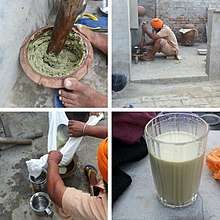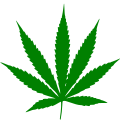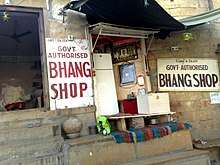Bhang
Bhang (Hindi: भांग) is an edible preparation of cannabis originating from the Indian subcontinent.[2] It has been used in food and drink as early as 1000 BC in ancient India.[3][4] Bhang is traditionally distributed during the spring festival of Holi.[5][6] Bhang is mainly used in bhang shops, which sell the cannabis-infused Indian drinks bhang lassi and bhang thandai.

| Part of a series on |
| Cannabis |
|---|
 |
|
|
|
|
Regional
|
|
Variants |
|
Western documentation
Garcia de Orta, a Portuguese Jewish physician based in Goa, wrote extensively on bangue in his Colóquios dos simples e drogas da India (1563), including its recreational use by Bahadur Shah of Gujarat and by many Portuguese. He explicitly rejects the notion that the Indian plant which produces bangue is the same as the European hemp plant (alcanave).
In 1596, Dutchman Jan Huyghen van Linschoten wrote three pages on "Bangue" in a work documenting his journeys in the East, also mentioning the Egyptian Hashish, Turkish Boza, Turkish Bernavi, and Arabic Bursj forms of consumption.[7] Despite these other accounts, the contemporary historian Richard Davenport-Hines lists the late seventeenth, early eighteen century British adventurer, Thomas Bowrey, as the first Westerner to document the use of bhang.[8]
Preparation
Using mortar and pestle, the leaves of cannabis are ground into a paste which can be added to foods. For a beverage it is mixed with milk and filtered, then often flavored with kusha grass, sugar, fruit, and various spices. During festivals it is most used by krishna devotees. In Mathura it can be found in bhang thandai and bhang lassi. Bhang is also mixed with ghee and sugar to make a purple halva, and into peppery, chewy little balls called goli (which means "tablet" as well as "pill" in Hindi). Another form is bhang chutney also called 'bhangeera ki chutney', a dish served in Kumaoni cuisine from Uttarakhand. It's made from grinding cannabis/bhang seeds with mint, tomatoes and different spices.
Culture
.jpg)
Bhang is part of the ancient Hindu tradition and custom in the Indian subcontinent. In some parts of rural India, people attribute various medicinal properties to the cannabis plant. If taken in proper quantity, bhang is believed to cure fever, dysentery, sunstroke, to clear phlegm, aid in digestion, appetite, cure speech imperfections and lisping, and give alertness to the body.[9]
Bhang lassi is a preparation of powdered green inflorescence with curd and whey put in a village blender (a hand blending operation is carried out till the butter rises). It is regarded as tasty and refreshing. It is legal in many parts of India and mainly sold during Holi, when pakoras containing bhang are also sometimes eaten. Uttar Pradesh has licensed bhang shops, and in many places in India one can buy bhang products and drink bhang lassis.
The tradition of consuming bhang lassi during Holi is particularly common in North India where Holi itself is celebrated with a fervor unseen elsewhere. Bhang is heavily consumed in Mathura, an ancient town of religious importance to the Hindus. Here the practice is believed to have been introduced by the followers of Krishna and has stayed ever since. They begin the preparation by Sanskrit chants and recitation of prayers. In Mathura, some people take bhang to work up their appetite while others do it to de-stress. But the hub of bhang use is Varanasi where the bhang is prepared on its famous ghats.
Bhang is also available as bhang goli which is just freshly ground cannabis with water. Apart from this, sweetened bhang golis are also widely available; these are not considered a drug, but a traditional sleeping aid and appetizer. Bhang goli has metabolizing effects after approximately two hours, sending a user into a dreamlike meditational state. Bhang is also part of many Ayurvedic medicinal preparations. Bhang powder is available legally at ayurvedic dispensaries.
Legality

The 1961 Single Convention on Narcotic Drugs was the first ever international treaty to have included cannabis (or marijuana) with other hard drugs and imposed a blanket ban on their production and supply except for medicinal and research purposes. [10]
As bhang has served such an important role in India's culture and spiritual practices, it would be impossible to criminalise cannabis completely in the country. Important festivals such as Holi have traditionally seen people consume bhang during various local festivities. Cultivation of cannabis is government regulated.
The cultivation of industrial hemp is legal in Uttarakhand.[11]
See also
- Desi daru
- Cannabis in India
- Cannabis in Tanzania
- List of Indian beverages
- Spiritual use of cannabis
- Charas
- Milkshake
- Siemieniotka
References
- Ayyagari S (2007). ""Hori Hai": A Festival of Colours!! (review)". Asian Music. Johns Hopkins University Press. 38 (2): 151–153. doi:10.1353/amu.2007.0029.
- Torkelson, Anthony R. (1996). "The Cross Name Index to Medicinal Plants, Vol. IV: Plants in Indian medicine, p. 1674, ISBN 9780849326356, OCLC 34038712". CRC Press.
- Staelens, Stefanie. "The Bhang Lassi Is How Hindus Drink Themselves High for Shiva". Vice.com. Retrieved 10 August 2017.
- Courtwright, David T. (2009). Forces of Habit. Harvard University Press. ISBN 978-0-674029-90-3.
- "Right kick for day-long masti". The Times of India. 16 March 2014. Retrieved 7 April 2019.
- "Holi 2014: Festival Of Colors Celebrates Spring (SONGS, PHOTOS)". Huffington Post. Retrieved 17 March 2014.
- Burnell, Arthur Coke & Tiele, P.A (1885). The voyage of John Huyghen van Linschoten to the East Indies. from the old English translation of 1598: the first book, containing his description of the East. London: The Hakluyt Society. pp. 115–117. Full text at Internet Archive. Chapter on Bangue.
- Davenport-Hines, Richard (2001). The Pursuit of Oblivion: a global history of narcotics 1500—2000. London: Weidenfeld & Nicolson. pp. 1–2. ISBN 0297643754.
- Holi Festival, archived from the original on 17 October 2016, retrieved 8 June 2019 Tradition of Bhang
- "Recreational use of marijuana: Of highs and laws". timesofindia. Retrieved 1 March 2018.
- "Uttarakhand To Become First Indian State To Legalise Cannabis Cultivation". Indiatimes. Retrieved 12 March 2017.
External links
| Wikimedia Commons has media related to Bhang. |
- Bhang Ganja Charas, Thandai Chai Lassi, IndiaCurry.com
- "A Bit about Bhang"
- "A Word from the Indian Hemp Drugs Commission" A 19th century British report on Bbhang